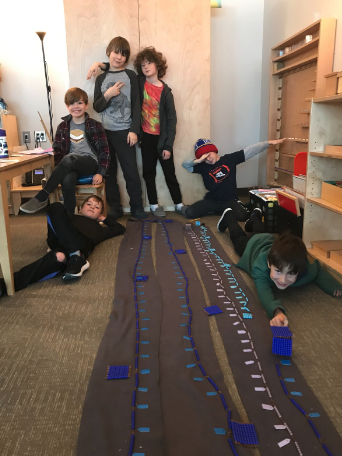written by Jessy Fabel, Spring Brook Guide
Imagine, eyes widening, mouth opening, and then…
“My tower of squares is taller than me!”
“If we tried to build the billion cube, it would be bigger than this room!”
“We don’t have the Proterozoic Era on our timeline of life - I want to make it! Whoa - I’m gonna need more room. Can I work on this in the hallway?!”
Timeline of Humans - Leif Thorkelson & Frankie Evans
Long Chains! This material helps the child practice multiplying numbers up to a number cubed. The students here have completed 9 cubed, 6 cubed, and 5 cubed. Left to right - Mac Trosvig, Oliver Bock, Simeon Thompson, Amos Keitel, Elliot Donnelly, Wesley Machacek
Sometimes the one thing that will shake the lethargic student on a Monday morning out of their fog is BIG WORK. Montessori education is about helping the child understand their purpose and their space in the world. The materials and the work are the tools that help the child discover that purpose.
What are the elements of Big Work? Mazer (2023), Senior Vice President of Programs at Guidepost Montessori, states the following:
Lessons: Big Work requires students to pull from, and elaborate on, a toolbox of skills and knowledge.
Materials: Huge poster boards, timeline paper that can stretch from wall to wall, markers, paints, clay, and pastels that invite students to explore.
Uninterrupted work periods: This kind of work doesn’t get done in a 40-minute math class, or as homework. The full, three-hour open-ended work cycle of a Montessori classroom provides the time to focus deeply and create something unique, no matter how long it takes.
Expectations for excellence: Big Work requires a lot of meticulous effort. The student who created a book of limericks had written a first draft of each limerick, by hand, and asked his teacher for edits. Only then did he copy the poems, in beautiful cursive, into the book. A culture of revisions, of multiple drafts, and of high standards is essential for Big Work to happen.
The children themselves: One of the reasons Big Work is so magical is that no two students will create the same thing. The same lesson on anatomy, in the same classroom, with the same materials and expectations, will lead to a salt-dough skeleton from one child, an illustrated book from a second, and a timeline of historical discoveries from a third. It is the magic of the elementary age to take what is offered—lessons, materials, work time, and expectations—and combine them in ways that are new and wonderful.
“Big Work in Elementary Classrooms,” https://www.guidepostmontessori.com/blog/big-work-in-elementary-classrooms
Coin Error & Value Research
By Jules Narabrook
While Big Work can literally be physically big, it can also inspire deep thinking, planning, and creativity. Going Outs are perfect examples of Big Work, taking what the child has learned in the classroom out into the world. The amount of planning that goes into organizing a Going Out is not for the faint of heart. The child has to research a topic, write down questions that they want answered on their outing, plan the trip … Will they walk? Will they take the bus? Will they need to purchase tickets? Will they need to bring lunch? What time do they need to start heading back to school? They will need to reach out to chaperones to accompany them and help make sure they are safe, but they are in charge of reading directions and getting to their destination. In our classroom, we’ve had students plan trips to the local library, the grocery store to get ingredients for a recipe, Como Zoo to study vertebrates, the MN History Center to learn about mining and how Dakota people use all the parts of the buffalo, and more!
Going Out to Como Zoo to study felines and buy a souvenir :)
Marion Gallas & Isla Lundy
Ultimately, we as guides want the children to take their knowledge, continue to be curious, and go out to discover more! Planting the seed with some sort of idea, story, material and giving the child the gift of uninterrupted time is often all the child needs to feel inspired enough to take off and begin their Big Work.
"An interesting piece of work, freely chosen, which has the virtue of inducing concentration rather than fatigue, adds to the child's energies and mental capacities, and leads him to self-mastery." - Montessori (1949), The Absorbent Mind, p. 207




